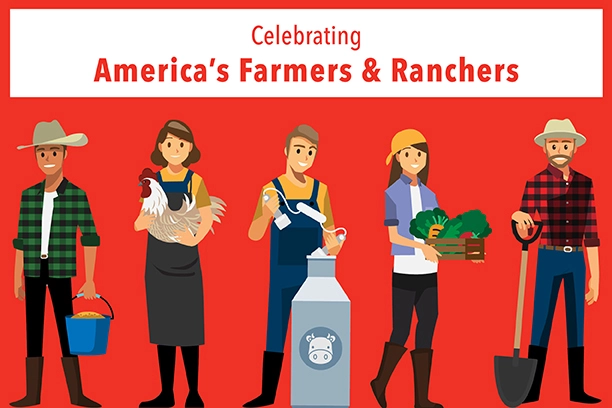Celebrating National Ag Week: Test Your Knowledge


Farmers and ranchers are the backbone of America. They work in the unforgiving heat and bitter cold to put food on our tables, fuel in our vehicles and clothing on our backs. March 17-23 is National Ag Week, and we’re proud to salute our nation’s farmers and ranchers.
Do you know these facts about your favorite foods and products raised by America’s farmers and ranchers?
Next time you’re at the store, take a moment to consider where things really came from—and thank a farmer when you see them!
Question: What is the safe cooking temperature for raw, whole cuts of steak, ham, pork and fish?
Answer: 145ºF
Spoiler alert: you should own a meat thermometer! According to FoodSafety.gov, the safe internal temperature for raw, whole cuts of steak, ham, pork and fish is 145 ºF. All of these except fish also require three minutes of rest time following cooking.
That said, different cuts of meat may have different safe internal temperatures. Ground meat needs to reach 160°F and poultry, such as chicken, needs to reach 165 ºF. It’s recommended to always use a meat thermometer to ensure the internal temperature is hot enough to eliminate harmful germs and bacteria while providing the best eating experience.
Question: What determines the color of an egg?
Answer: The breed of the hen determines the color of her eggs.
White, brown, green, blue – when it comes to nutritional value, they’re all pretty much the same. But what determines the egg’s color?
According to the Egg Safety Center, the breed of the chicken determines eggshell color. The color of a hen’s ear area is the color indicator, with a white or light spot meaning white eggs. Usually, white hens lay white eggs, and brown hens lay brown eggs.
Question: What is produced from one bale of cotton?
Answer: One bale of cotton can produce almost 300 pairs of jeans or over 300,000 $100 bills.
When you think of cotton, you likely are picturing a t-shirt, your bed sheets, bathroom towels or your toiletries. As a plant and fiber, cotton’s versatility produces thousands of useful products. The National Cotton Council of America shares that cotton doesn’t just become clothing and toiletries. Cotton seeds are often turned into seed oils to cook with and become the base of your favorite crackers and chips. The plant can also be turned into feed or meal for livestock, poultry and fish.
Question: How many gallons of milk are produced in the US each year?
Answer: Between dairy cows and dairy goats, over 220 billion pounds of milk are produced. That’s enough for each person in the US to drink over 70 gallons of milk each year.
While milk from cows has long been a household staple to drink, it’s likely that the average American is not consuming 70 gallons of milk each year. However, there are many products that begin with a base of milk. The International Dairy Foods Association tells us that the fats in milk produce half and half, heavy cream, butter, sour cream, cottage cheese, ice cream, cheese and much more! It serves as the base for many of your food favorites. The largest portion of the dairy supply chain is from cow’s milk, but we can’t forget about other popular milk producing animals such as dairy goats.
The products made from dairy goats have quickly become a companion to those who love dairy staples. Common uses for goat milk are cheese, lotion, soap, ice cream and much more. Plus, milk is nutrient-rich, containing calcium and potassium that help keep a balanced diet, whether it’s from cows, goats or another milk source.
At Farm Bureau, we’re proud of our agricultural roots. There’s no doubt it’s because of farmers and ranchers that the world keeps turning. To all of America’s farmers and ranchers—Happy National Ag Day. We’re grateful for you today and every day.